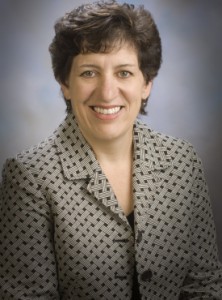
Ellen Fisher is the recipient of a prestigious honor from the American Vacuum Society.
Ellen Fisher – professor in the Department of Chemistry and assistant vice president for strategic initiatives in the Office of the Vice President for Research – has been awarded the 2020 Plasma Prize from the American Vacuum Society (AVS) in the Plasma Science and Technology Division (PSTD), making her the second woman to receive this honor in the history of the award.
The Plasma Prize is the highest honor of the AVS PSTD, dating back to 1999. Attracting a large pool of accomplished leaders, the prize is annually awarded to someone who has conducted outstanding research in plasma science and technology.
“This award came as a real surprise; I did not even know I had been nominated,” Fisher said. “It means an enormous amount to me as the AVS has been an integral part of my professional life, and to receive this recognition is truly an honor.”
For nearly 30 years, Fisher has been part of the AVS PSTD. She has helped promote diversity, equity, and inclusion efforts; and she has been a strong proponent of promoting women in STEM disciplines – not just to get them engaged in the field, but to have them recognized for the work they do.
“I hope over the next few years, the imbalance in who is recognized by this award continues to decrease,” Fisher said, “and that we as a professional society continue to be broad-minded in how we view individual contributions to the advancement of the field.”
Accolades and understanding the fundamental chemistry of plasmas
Since she started at CSU in 1993, Fisher has been an integral part of the Department of Chemistry and the Office of the Vice President for Research. Among her many accomplishments, Fisher has helped incorporate ethics topics and concepts into University classrooms; she has promoted women in science through the CSU Women’s Studies program; and she has created opportunities for graduate students University-wide to be recognized and funded for outstanding research. Fisher serves as a mentor to many.
Fisher’s research group provides insight into the fundamental chemistry of very complex systems, namely plasmas. Plasmas are partially ionized gases that have a plethora of different types of reactive species, which the group works on deconstructing to better understand each one.

“I often liken it to vegetable soup,” said Fisher. “When you have so many different things in the same pot, it’s challenging to understand what each individual thing is contributing to the overall ‘flavor’ of the end product. It’s important to have a deep understanding of those individual species and their reactions (flavor contributions) as plasmas are used in many value-added applications such as semiconductor manufacturing (computer chips); contact lens manufacturing; pollution remediation, textiles and more.”
Currently, the Fisher Group is focused on plasma-assisted catalysis (PAC), specifically understanding how plasmas can enhance the catalytic activity of catalysts. An example would be converting nitrogen oxides to harmless products during engine exhaust pollution remediation.
The group is also seeking to use plasmas to enhance the efficiency of nanostructured metal oxide sensors used to detect noxious gases like carbon monoxide and nitrogen oxides.
Since there will be no in-person events this year for the AVS, Fisher will receive the award in person and give a lecture at the next planned PSTD Business Meeting in Charlotte, North Carolina in 2021. This presentation will likely focus on Fisher’s PAC work as well as any new results on the group’s nanostructured materials work.
The AVS is a nonprofit organization that promotes communication, education, networking, recommended practices, research, and the dissemination of knowledge on an international scale, in the application of vacuum and other controlled environments to understand and develop interfaces, new materials, processes, and devices through the interaction of science and technology.